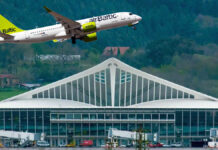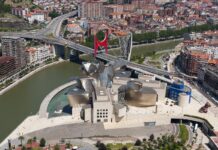This article was translated by John R. Bopp
The twentieth anniversary of the opening of the Bilbao Guggenheim Museum has caused a flurry of articles and reports across the web, telling the story of these twenty glistening years for this Basque museum.
As we’ve said so many times before, the world is still surprised (like many “locals” who would have paid for it to be a failure) by this “success story”, and how it’s turned into a global reference point. It’s even been able to steal the Guggenheim brand from New York.
We can’t discuss all the articles that are being published, because that would just completely overwhelm our processing power. But on this anniversary of a triumph in betting on the future of our country, we would like to discuss an article we found very special.
It’s an analysis by urbanist Richard Layman, who we mentioned back in 2013 regarding an extraordinary article of his on the keys to understanding the Transformation of Bilbao. It’s very unlike the “parachutists” who either don’t know what they’re talking about, or who came to Bilbao with the only aim of finding the “trick” to this success, and when they can’t find it, dedicate themselves to lying to and deceiving their readers.
We believe the best praise for the Bilbao Guggenheim is by placing it as the keystone to the transformation process not only of a city but also of a country: the Land of the Basques. It’s a brilliant and powerful element that fits in perfectly with the complex “transmutation” plan in which all the parts have been necessary for success. This is how our expert Mr. Layman does it, describing the key elements, the lines of planning and work, that made it possible.
We did find it curious, as we did back in 2013, to come across a comment to the article, signed by the same person, that sows doubt about what’s happening in our country. The author claims that there is a desire to promote a model of “strong province / weak state”.
There is no such desire. Actually, there is simply an ongoing historical reality that the Basques want to maintain their sovereignty. We Basques have always governed ourselves, except when prevented from doing so by force. To understand this better, we would ask our “astute” commenter, and indeed all our readers, to read what John Adams, one of the Founding Fathers of the US and its second president, had to say about the Basques. He was quite clear on how the Basques (more specifically, the Biscaynes) governed themselves when he wrote his book A defence of the constitutions of government of the United States of America (published in London in 1787) and dedicated an entire chapter to Biscay.
We’ll leave you with Richard Layman’s very interesting analysis, where we can find references to the many reflections he’s had over these past two decades about the process of the transformation of Bilbao.
Rebuilding Place in the Urban Space – 24/12/2013 – USA
Why can’t the Bilbao Effect be reproduced? | Bilbao as an example of Transformational Projects Action Planning
“THE BILBAO EFFECT’S SECRET INGREDIENTS: PLANNING, RELATIONSHIPS, FUNDING, IMPLEMENTATION,” Europe in Baltimore i was pretty pleased with the article, especially because afterwards I heard from people in Bilbao who said that I had captured very well the essence of their approach, process, and program. It was but one of many examples that shaped my thinking about the need for what I am now calling “Transformational Projects Action Plans” and the Transformational Projects Action Planning process, as an essential element of Comprehensive Land Use Plans/Community Master Plans.
(Continue) (Automatic Translation)
Last Updated on Dec 20, 2020 by About Basque Country
































